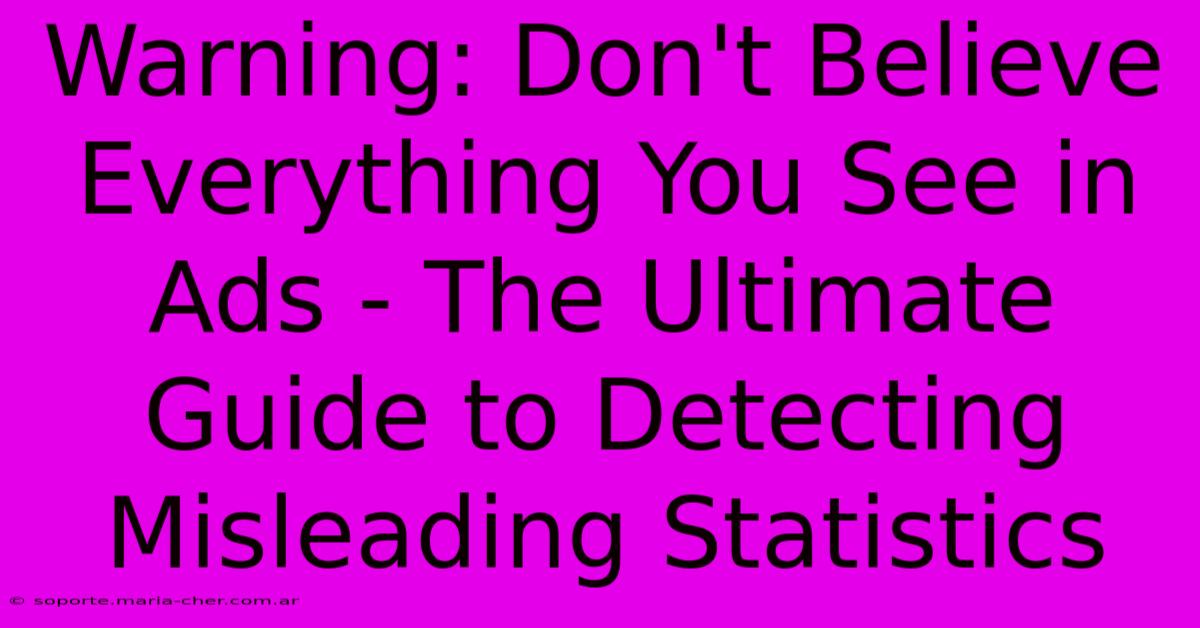Warning: Don't Believe Everything You See In Ads - The Ultimate Guide To Detecting Misleading Statistics

Table of Contents
Warning: Don't Believe Everything You See in Ads - The Ultimate Guide to Detecting Misleading Statistics
We're bombarded with ads daily. Slick visuals, catchy jingles, and compelling promises fill our screens and airwaves. But lurking beneath the surface of many advertisements are misleading statistics, cleverly designed to manipulate our perceptions and influence our purchasing decisions. This guide will equip you with the critical thinking skills to spot these deceptive tactics and make informed choices.
Understanding the Tricks of the Trade: How Ads Misuse Statistics
Advertisers often employ sophisticated techniques to distort data and present a skewed reality. Let's explore some common culprits:
1. Cherry-Picking Data: The Illusion of Perfection
This involves selecting only the data that supports the desired conclusion while ignoring contradictory evidence. For example, an ad might boast a "90% customer satisfaction rate" without mentioning that the survey only included customers who actively opted to participate—a self-selected group likely to be more positive. Always ask: What data is missing? How was the sample selected?
2. Misleading Graphs and Charts: A Visual Deception
Visually manipulating charts and graphs is a powerful tool for misleading viewers. Truncated y-axes, disproportionate scales, and lack of context can drastically alter the perception of data. Look closely at: the axis labels, the scale used, and the overall context of the visual. If something seems "too good to be true," it probably is.
3. Playing with Percentages: The Power of Numbers
Percentages can be incredibly misleading when taken out of context. A statement like "50% more effective!" sounds impressive, but what is it 50% more effective than? Without a clear benchmark, this claim is meaningless. Always ask: What is the comparison being made?
4. Vague and Unquantifiable Claims: The Art of Ambiguity
Words like "improved," "enhanced," and "better" are subjective and lack concrete meaning. These vague claims avoid the need for factual backing and allow advertisers to make bold assertions without accountability. Demand specifics: What exactly is being improved? By how much?
5. Correlation vs. Causation: The Fallacy of False Connection
Just because two things occur together doesn't mean one caused the other. Advertisers often exploit this correlation-causation fallacy to link their product to positive outcomes without demonstrating a genuine causal link. Think critically: Is there a proven causal relationship, or is it simply a coincidence?
Developing Your Critical Eye: How to Spot Misleading Statistics in Ads
Becoming a savvy consumer of advertising requires a healthy dose of skepticism and critical thinking. Here are some practical steps:
- Look for the Fine Print: Many ads contain disclaimers and qualifications buried in small text. Don't skip over this crucial information.
- Be Wary of Unnamed Sources: If an ad cites a statistic, it's essential to know its source. Reputable sources provide more credibility than anonymous claims.
- Consider the Source: Is the advertisement coming from a reliable and unbiased source? Companies have vested interests in presenting their products in the most positive light.
- Verify Claims Independently: Don't just accept claims at face value. Do your own research to verify the accuracy of the statistics presented.
- Seek Multiple Perspectives: Look for reviews and opinions from independent sources, not just the company promoting the product.
The Bottom Line: Informed Consumers Make Better Choices
By understanding the common tactics used to mislead with statistics, and by developing your critical thinking skills, you can navigate the world of advertising with greater confidence. Remember, a healthy skepticism is your best defense against misleading marketing and the key to making informed decisions. Don't let deceptive statistics sway your choices – empower yourself with knowledge and critical thinking.

Thank you for visiting our website wich cover about Warning: Don't Believe Everything You See In Ads - The Ultimate Guide To Detecting Misleading Statistics. We hope the information provided has been useful to you. Feel free to contact us if you have any questions or need further assistance. See you next time and dont miss to bookmark.
Featured Posts
-
Vermeil When Gold Meets Metal Unraveling The Alchemy
Feb 08, 2025
-
Escape The Asylum With One Who Flew Over The Cuckoos Nest Free Pdf
Feb 08, 2025
-
May Hem In Your Inbox 10 Newsletters You Cant Miss For A Month Of Inspiration
Feb 08, 2025
-
From Sheepskin To State Pride The Story Behind Boise States Iconic Uniforms
Feb 08, 2025
-
Happiness Unleashed Elios Happy Meal The Secret To Pure Joy
Feb 08, 2025
